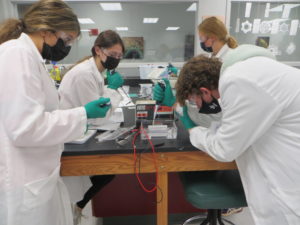It is that time of the school year when the mind starts to drift to the following school year. To be clear, I am very eager for summer vacation to begin. That noted, I still begin to think about what I might do differently next year. Should I change the flow of the semester by reorganizing the order of the units? Should I clarify one or more topics by redoing the notes or finding a different reading? Is there a better way to assess learning?
While it can be exciting to consider all of those possibilities, what really gets me thinking is considering new labs – whether it be to demonstrate new concepts or to cover old concepts but from a new angle. However, having students perform these new labs can also be the most nerve-wracking piece of lesson planning. There are so many things that can go wrong. What if the students do not understand the directions? What if the lab does not help to make the concept easier to understand? Worst of all, what if the lab does not work?
During the past couple of weeks, I have been putting my Biotech students to work trying out new labs for next year. The beauty of using them doing this is that they have good lab techniques, know when to ask questions for clarification, and are not shy about sharing what they think. The first piece (good lab techniques) is essential. If they cannot get the lab to work, students with lesser skills certainly will not. The second piece (asking questions) is super helpful. The students know not to assume that they fully understand a set of new lab directions and that without their questioning the experiment may not work. The third (sharing what they think) is crucial for honest feedback.
And do they share.
They let me know what directions made sense and which need rewriting. They tell me which of the intended main concepts were truly emphasized and which ones still lacked clarity. They put themselves in the position of students who might have lesser skills and what would be a struggle for them to do. They also suggest new ways of looking at the data.
One lab that they tried recently was focused on collecting evidence of transcription and translation using fluorescent signals. They thought the concept was cool. They loved seeing the colors and thought other students would be intrigued by the colors, too. Ultimately, however, they thought that the lab didn’t make the concepts of transcription and translation any clearer (I would have to agree). I have no plans on using this lab next year.
Another lab looked at enzymes also using fluorescent signals. They also loved this lab. It was very clear to them how to know if the enzymes were working. They suggested that there would be a way to compare reaction rates between different conditions (like temperature and pH). The students thought it would be good lab for students new to biotechnology, but they expressed concern that the tiny tubes would be really hard to work with for students who are inexperienced with micropipetting. They also suggested that new students might need another day to collect and analyze data. All valid points and I concur. I am planning on using this lab next year, but will make some revisions and budget enough time.
Finally, they tried a new lab which involved CRISPR. I have done a short unit on CRISPR the past few years and included a paper/pencil demo, but have never done an actual lab with students. This lab was a resounding success. Students communicated that the directions made sense. They asked great “What would happen if . . .” questions which showed that they understood what was happening. Perhaps most importantly, all of them got it to work. This lab was a winner. Not only will I be doing it next year with my students, but I will also be finding a way to share it with teachers in the Biotech: Beyond the Basics course at the BTC Institute this summer!
Overall, the students knew that their purpose was to “test drive” these labs. This gave them a higher sense of purpose. They were doing more than just another lab and had a vested interest in making sure that next year’s class had a good lab experience. The students also gained some insights into what science teachers have to do in order to introduce a new lab into the curriculum. On my end, I gained valuable insights from their efforts and was able to determine which labs to keep, to tweak, and to leave behind before using it “for real” next year.
I’ll reconnect in September – have a great summer!
